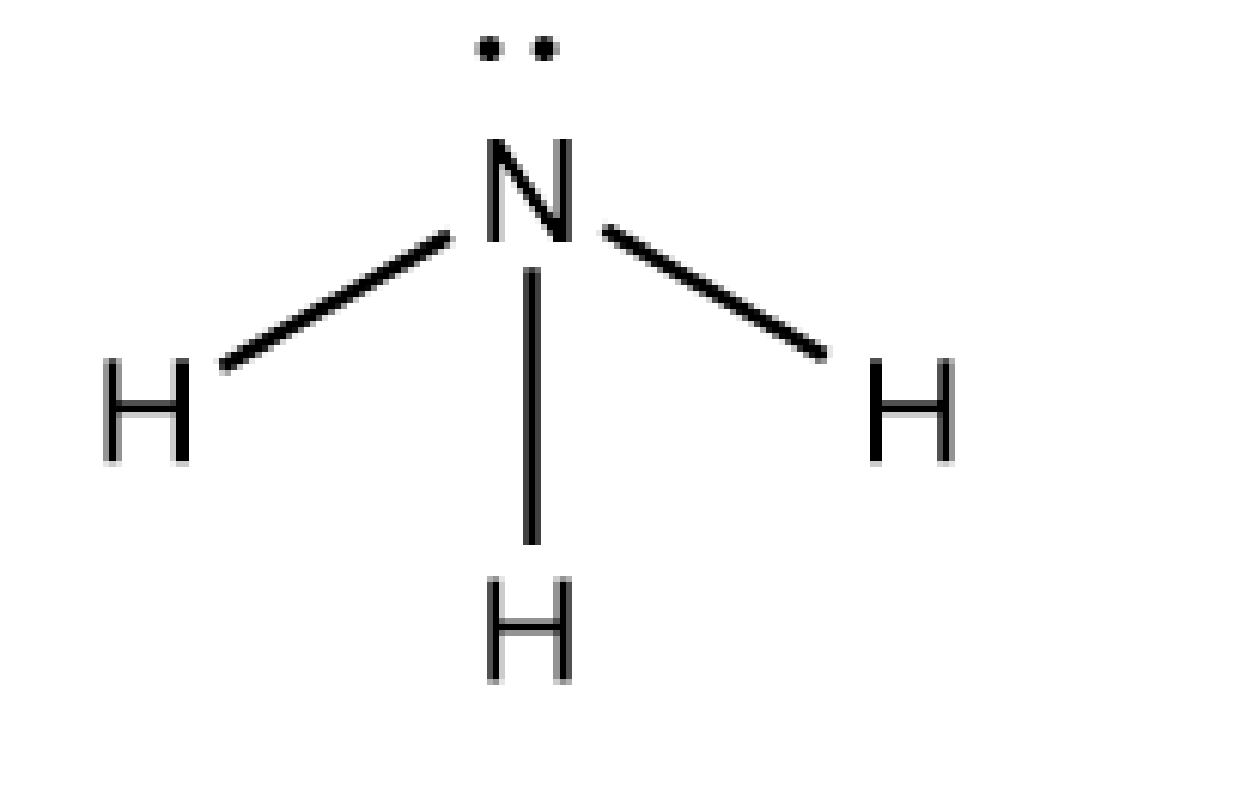
Structure of ammonia is:
A) Trigonal
B) Tetrahedral
C) Pyramidal
D)Trigonal pyramidal
Answer
216.3k+ views
Hint: The VSEPR theory helps in the prediction of the shape of molecules. This theory predicts shape on the basis of lone pairs and bond pairs surrounding the central atom. Here, we will use the VSEPR theory to identify ammonia's shape.
Complete Step by Step Answer:
Let's discuss the structure of ammonia. The ammonia is written by the formula of \[{\rm{N}}{{\rm{H}}_{\rm{3}}}\]. The nitrogen atom forms three bond pairs with the hydrogen atom. The count of valence electrons of the N atom in ammonia is five, and three electrons are used in the formation of covalent bonds with H atoms. And one lone pair is present.

Image: Structure of ammonia
Let's discuss the electron pair geometry of ammonia. As the molecule has three numbers of bond pairs and one lone pair, the electron pair geometry of ammonia is tetrahedral. As one lone pair and three numbers of bond pairs are present, the molecular shape of the ammonia molecule is trigonal bipyramidal.
Hence, option D is right.
Additional Information: Ammonia is a gas that has no colour. It possesses a distinct smell. It is a nitrogenous waste among aquatic organisms. It is an important component of many fertilisers. The pure form of ammonia can be directly applied to soil for fertility.
Note: If the electron pair geometry is tetrahedral, there are three possibilities, if no lone pair is present, then the shape of the molecule is tetrahedral. If one lone pair is present, the shape is trigonal bipyramidal (ammonia) and if two lone pairs are present, the shape is bent.
Complete Step by Step Answer:
Let's discuss the structure of ammonia. The ammonia is written by the formula of \[{\rm{N}}{{\rm{H}}_{\rm{3}}}\]. The nitrogen atom forms three bond pairs with the hydrogen atom. The count of valence electrons of the N atom in ammonia is five, and three electrons are used in the formation of covalent bonds with H atoms. And one lone pair is present.

Image: Structure of ammonia
Let's discuss the electron pair geometry of ammonia. As the molecule has three numbers of bond pairs and one lone pair, the electron pair geometry of ammonia is tetrahedral. As one lone pair and three numbers of bond pairs are present, the molecular shape of the ammonia molecule is trigonal bipyramidal.
Hence, option D is right.
Additional Information: Ammonia is a gas that has no colour. It possesses a distinct smell. It is a nitrogenous waste among aquatic organisms. It is an important component of many fertilisers. The pure form of ammonia can be directly applied to soil for fertility.
Note: If the electron pair geometry is tetrahedral, there are three possibilities, if no lone pair is present, then the shape of the molecule is tetrahedral. If one lone pair is present, the shape is trigonal bipyramidal (ammonia) and if two lone pairs are present, the shape is bent.
Recently Updated Pages
JEE Atomic Structure and Chemical Bonding important Concepts and Tips

JEE Amino Acids and Peptides Important Concepts and Tips for Exam Preparation

Electricity and Magnetism Explained: Key Concepts & Applications

Chemical Properties of Hydrogen - Important Concepts for JEE Exam Preparation

JEE Energetics Important Concepts and Tips for Exam Preparation

JEE Isolation, Preparation and Properties of Non-metals Important Concepts and Tips for Exam Preparation

Trending doubts
JEE Main 2026: Application Form Open, Exam Dates, Syllabus, Eligibility & Question Papers

JEE Main Correction Window 2026 Session 1 Dates Announced - Edit Form Details, Dates and Link

Derivation of Equation of Trajectory Explained for Students

Hybridisation in Chemistry – Concept, Types & Applications

Understanding the Angle of Deviation in a Prism

Understanding Collisions: Types and Examples for Students

Other Pages
NCERT Solutions For Class 12 Chemistry Chapter 1 Solutions - 2025-26

NCERT Solutions for Class 12 Chemistry Chapter Chapter 7 Alcohol Phenol and Ether

NCERT Solutions ForClass 12 Chemistry Chapter Chapter 8 Aldehydes Ketones And Carboxylic Acids

JEE Advanced Marks vs Ranks 2025: Understanding Category-wise Qualifying Marks and Previous Year Cut-offs

Haloalkanes and Haloarenes Class 12 Chemistry Chapter 6 CBSE Notes - 2025-26

Solutions Class 12 Chemistry Chapter 1 CBSE Notes - 2025-26




